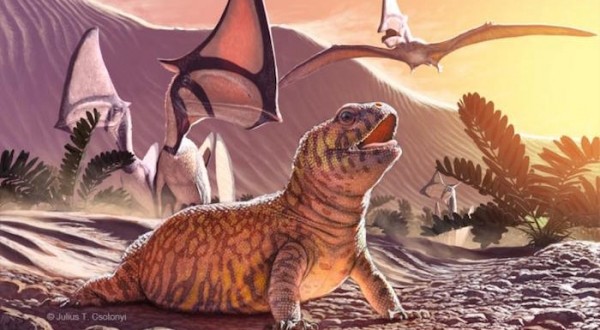A new species of lizard may just be the missing link for lizard evolution. Scientists have discovered a fossil lizard, named Gueragama sulamericana, which dates back to the outcrops of a Late Cretaceous desert that existed about 80 million years ago.
“The roughly 1700 species of iguanas are almost without exception restricted to the New World, primarily the Southern United States down to the tip of South America,” says Michael Caldwell, biological sciences professor from the University of Alberta and one of the study’s authors. Oddly however, iguanas closest relatives, including chameleons and bearded dragons, are all Old World. As one of the most diverse groups of extant lizards, spanning from acrodontan iguanians (meaning the teeth are fused to the top of their jaws) dominating the Old World to non-acrodontans in the New World, this new lizard species is the first acrodontan found in South America, suggesting both groups of ancient iguanians achieved a worldwide distribution before the final break up of Pangaea.
A terrestrial Noah’s Arc
“This fossil is an 80 million year old specimen of an acrodontan in the New World,” explains Caldwell. “It’s a missing link in the sense of the paleobiogeography and possibly the origins of the group, so it’s pretty good evidence to suggest that back in the lower part of the Cretaceous, the southern part of Pangaea was still a kind of single continental chunk.”
Distributions of plants and animals from the Late Cretaceous reflect the ancestry of Pangaea when it was whole. “This Gueragama sulamericana fossil indicates that the group is old, that it’s probably Southern Pangaean in its origin, and that after the break up, the acrodontans and chameleon group dominated in the Old World, and the iguanid side arose out of this acrodontan lineage that was left alone on South America,” says Caldwell. “South America remained isolated until about 5 million years ago. That’s when it bumps into North America, and we see this exchange of organism north and south. It was kind of like a floating Noah’s Arc for a very long time, about 100 million years. This is an Old World lizard in the new world at a time when we weren’t expecting to find it. It answers a few questions about iguanid lizards and their origin.”
The University of Alberta is a world leader in paleontology. This study was a collaboration between the University of Alberta and scientists in Brazil. Caldwell says of the collaboration, “It’s providing an opportunity for our students and research groups to expand our expertise and interests into an ever-increasing diversity of organisms within this group of animals called snakes and lizards.”
The lead author of the paper is Caldwell’s PhD student, Tiago Simoes, a Vanier scholar. “As with many other scientific findings, this one raises a number of questions we haven’t previously considered,” says Simoes. “This finding raises a number of biogeographic and faunal turnover questions of great interest to both paleontologists and herpetologists that we hope to answer in the future.”
In terms of next steps, Caldwell notes “Each answer only rattles the questions harder. The evolution of the group is much older than has been previously thought, which means we can push an acrodontan to 80 million years in South America. We now need to focus on much older units of of rock if we’re going to find the next step in the process.”
The findings, “A stem acrodontan lizard in the Cretaceous of Brazil revises early lizard evolution in Gondwana,” were published in the journal Nature Communications, one of the world’s top multidisciplinary scientific journals.
Agencies/Press Releases/Canadajournal
 Canada Journal – News of the World Articles and videos to bring you the biggest Canadian news stories from across the country every day
Canada Journal – News of the World Articles and videos to bring you the biggest Canadian news stories from across the country every day



